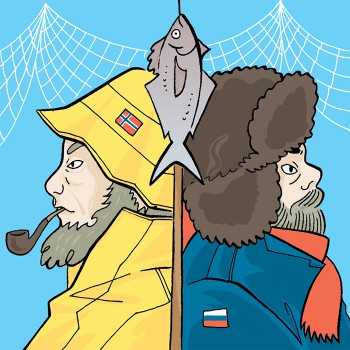When neither one nor two languages are enough to make yourself understood, it is time to delve into the fascinating world of hybrid languages, a hybrid or macaronic concoction of two languages that share the same lexical, grammatical and syntactical elements.
The magic of interlanguages is best shown through two distinct situations:
A) When, as a language learner you have yet to master your chosen language or have poor knowledge of a foreign language and find yourself replicating elements of your own language instead. Think: Je vais driver, in French, instead of Je vais conduire for, “I am going to drive.” Or when you use false friends like nobody’s business, like: Das ist groß, for “this is disgusting” in German, even though it means “this is big.”
B) When speakers from two entirely distinct communities attempt to speak in one common language in order to make themselves understood, create a common identity or even form trading partnerships with each other. There are hundreds of interlanguages in the world — but here are a few famous examples:

Illustrations by Eleonora Antonioni
A Few Well-Known Hybrid Languages
Portuñol/Portunhol
This is an interlanguage spoken in the Spanish-Portuguese border regions of the Iberian peninsula, as well as in South America between Brazil and Spanish speaking countries like Uruguay and Paraguay. Uruguay — which, according to historian Norman Berdichevsky, was established as a buffer state between the two major nations of Argentina and Brazil — is a good example. Much of its population in the north, around 260,000 people, speaks Portuñol. Their fluency is further consolidated by being able to receive and watch Brazilian TV stations in that area. Berdichevsky further claims that Portuñol is an attempt for Uruguayans (especially the younger generations) to establish their own distinct national identity and break free from the shadow of their powerful “macho” Argentine neighbors.
One of the best examples of Portuñol is a novel called Mar Paraguayo by Brazilian author Wilson Bueno, written in a mixture of Spanish, Portuguese, Portuñol and Guarani, (an indigenous language from Paraguay). Some examples of Portuñol include words like camiáu (lorry/truck) from camión in Spanish and caminhão in Portuguese or sentences like Dame este biscoito (give me this biscuit). In 2015, a group of artists and academics started a petition to have UNESCO recognise Portuñol as an Intangible Cultural Heritage.
Russenorsk/Руссенорск

A pidgin language that no longer exists, Russenorsk was spoken in the Arctic between Norway and Russia (think TV’s Fortitude) in the 18th and 19th centuries and combined elements of these two country’s languages. It was created as a means for Norwegian and Russian fishermen to trade with each other and mostly revolved around fishing and trade. Russenorsk’s influence decreased as the Russian-Norwegian border also decreased with Finland’s independence from Russia in 1917 and the formation of the Soviet Union in 1922.
Runglish/рунглиш

A macaronic language spoken in space! In 2000, NASA listed Runglish as one of the languages spoken between the English-speaking and Russian-speaking crew members of Expedition One, aboard the International Space Station. Runglish was also popularised in Arthur C. Clarke’s novel 2010: Odyssey Two, where a Russian and an American crew started a “Stamp out Russlish” campaign to crack down on boredom. Examples include: Слайсающий чиз (slaysayushiy chiz) for sliced cheese and Аисд кофе (Aisd kofe) for iced coffee. Back on Earth, you can still hear some Runglish being spoken in the Russian community of Brighton Beach in Brooklyn, New York.
Belgrano-Deutsch

A hybrid language spoken by the descendants of German immigrants to Begrano, a neighborhood in Buenos Aires. Germano-Argentinos or Deutsch-Argentinier make up the fourth largest immigrant group in Argentina, but unfortunately their language has not survived with them, and only a few words have made it into present-day vocabulary. Another similar macaronic language is Lagunen – German spoken around Lago Llanquihue in Chile. Examples include words like lechen (to milk) from melken in German and leche in Spanish and Vacke for cow from vaca in Spanish and Kuh in German, as well as sentences like, Das ist ein asco (this is disgusting).
Belgrano-Deutsch is not to be confused with Alemañol, which is spoken by Spanish speakers who live in German regions and includes examples like la banjof instead of der Bahnhof (the train station) and sentences like, Voy a la kela (I am going to the basement) from the German for basement (kellar), or Vamos a einkaufar? (Shall we go shopping?) from the German for shopping: einkaufen.
Spanglish/Inglañol
The term was first coined by Puerto Rican journalist and poet Salvador Tió in the 1940s and it describes a hybrid language spoken by Mexican-Americans, especially in Southern California, and other Hispanic communities in New York, Miami and Texas. It can also be heard in Panama and Puerto Rico but, make no mistake about it, there are distinct differences from one type of Spanglish to another, like el Dominicanish (Dominican and English), el Tex Mex (Mexican and English), el Cubonix (Cuban and English), etc. Spanglish, which is said to be spoken by around 40,000,000 people (nearly as many as the population of Spain) can be very difficult to decipher by native speakers of either English or Spanish.
Some examples include the use of English verbs with Spanish endings, eg. parquear (from “to park”) instead of estacionar, or rentar (from “to rent”) instead of alquilar, calques such as llamar para atras (from “to call back”) instead of devolver la llamada, Arnold Schwarzenegger’s iconic Hasta la vista, baby or this crazy sentence: Marla fue a la washateria pero no tenía un daim para estartear la máquina (Marla went to the launderette, but she didn’t have a coin to start the machine). Loco, huh?
This article was originally published on July 5, 2017, and has been updated.
Comment